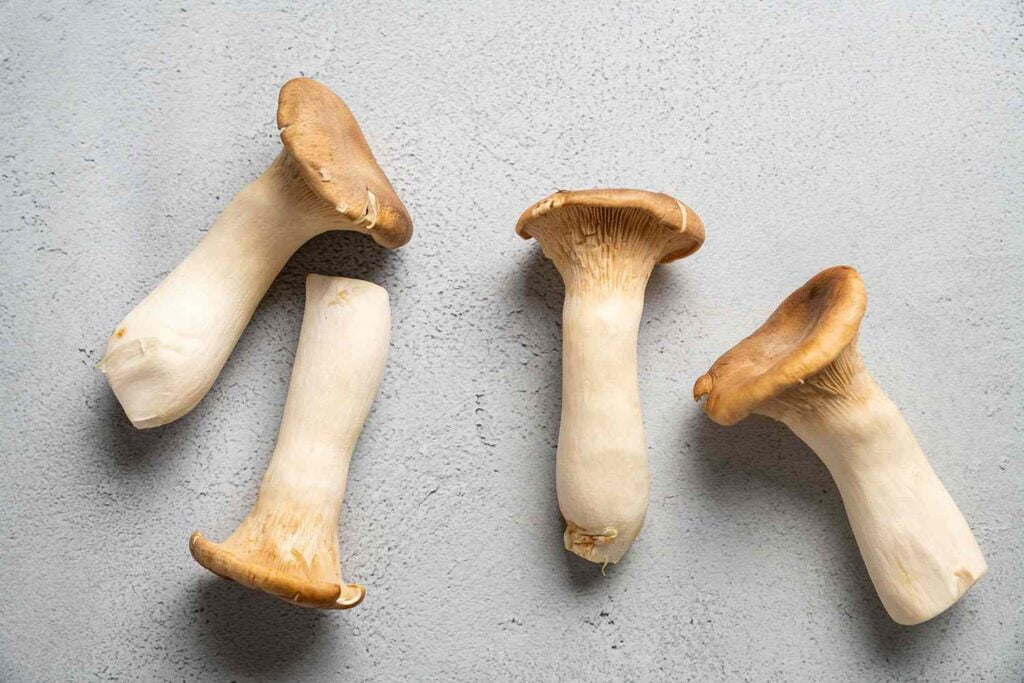INTRODUCTION
King Oyster mushrooms, scientifically labeled as Pleurotus eryngii, have gained renown for their abundant health benefits, boasting a wealth of antioxidants, most notably the amino acid ergothioneine, which plays a crucial role in maintaining various ailments. Emerging research indicates that these mushrooms hold a significant reservoir of antioxidants, thereby fostering the wellbeing of bodily cells

King Oyster mushrooms offer a range of health advantages, encompassing support for cardiovascular and immune system wellness, facilitation of balanced blood sugar levels, and provision of both antioxidant and anti-inflammatory properties.
With their low calorie and high fiber content, they stand as a commendable option for weight management. Additionally, the presence of beta-glucans contributes to immune enhancement and inflammation reduction within the body.
Nutritional Values of King Oyster Mushrooms
King Oyster mushrooms stand as a nutrient powerhouse, brimming with essential elements. In a 100-gram serving, they encompass 33 calories, 3 grams of protein, 0.4 grams of fat, 6 grams of carbohydrates, and 2.3 grams of beneficial dietary fiber.
Moreover, their nutritional profile boasts 420 milligrams of potassium, 38 micrograms of folate, 5 milligrams of Niacin (vitamin B3), 1.3 milligrams of Pantothenic acid (vitamin B5), and 0.3 milligrams of Riboflavin (vitamin B2), making them a rich source of vitamins, minerals, and nutrients.
Growing King Oyster Mushrooms
The cultivation of King Oyster mushrooms presents opportunities both indoors and outdoors. Found in the wild on decaying wood or dying trees, these mushrooms can be cultivated with finesse indoors.
The process involves cultivating them on supplemented hardwood sawdust within autoclavable grow bags, often enriched with 10 to 15 percent wheat bran. While they can also flourish on straw, it’s worth noting that opting for hardwood substrates results in a more bountiful yield compared to the use of straw.
Among small-scale mushroom cultivators, King Oyster mushrooms have gained popularity, even though they demand a bit more attention and time compared to the Pleurotus ostreatus species. An alternative technique comes into play when initiating a King Oyster mushroom growing setup or regenerating a substrate block.
Given the species’ unique tendency to regenerate from the top, it’s possible to remove the upper portion of the bag without the need to fold back the plastic covering. This ingenious method harnesses CO2 retention, a crucial factor for fostering robust, meaty stems especially in advanced CO2-rich environments.
While a covering substrate can be utilized with certain mushroom species to enhance moisture retention and improve the yield and quality of regenerating structures, its application remains entirely optional in the cultivation of King Oyster mushrooms.
Alternatively, gently scoring the upper surface of the growth medium within the container, without requiring bag opening, can effectively create favorable conditions for the development of King Oyster mushroom primordia.
The cultivation timeline for King Oyster mushrooms spans approximately three weeks from Agar or Liquid Culture to Grain, followed by another three weeks from Grain to Grain or Hardwood Substrate, leading to one week from the Fruiting Chamber to the 1st Flush, and subsequently 2 to 3 weeks from the 1st Flush to the 2nd Flush while maintaining elevated moisture levels.
The optimal temperature range for the growth phase is 10 – 25 degrees Celsius, while the fruiting conditions should fall between 7 – 20 degrees Celsius, coupled with humidity exceeding 80 percent.
CONCLUSION
King Oyster mushrooms extend beyond being a flavorful addition to diverse dishes; they also serve as a nourishing and health-promoting dietary source. Armed with the right expertise and resources, cultivating them at home can be seamlessly achieved, offering a sustainable and beneficial food supply.